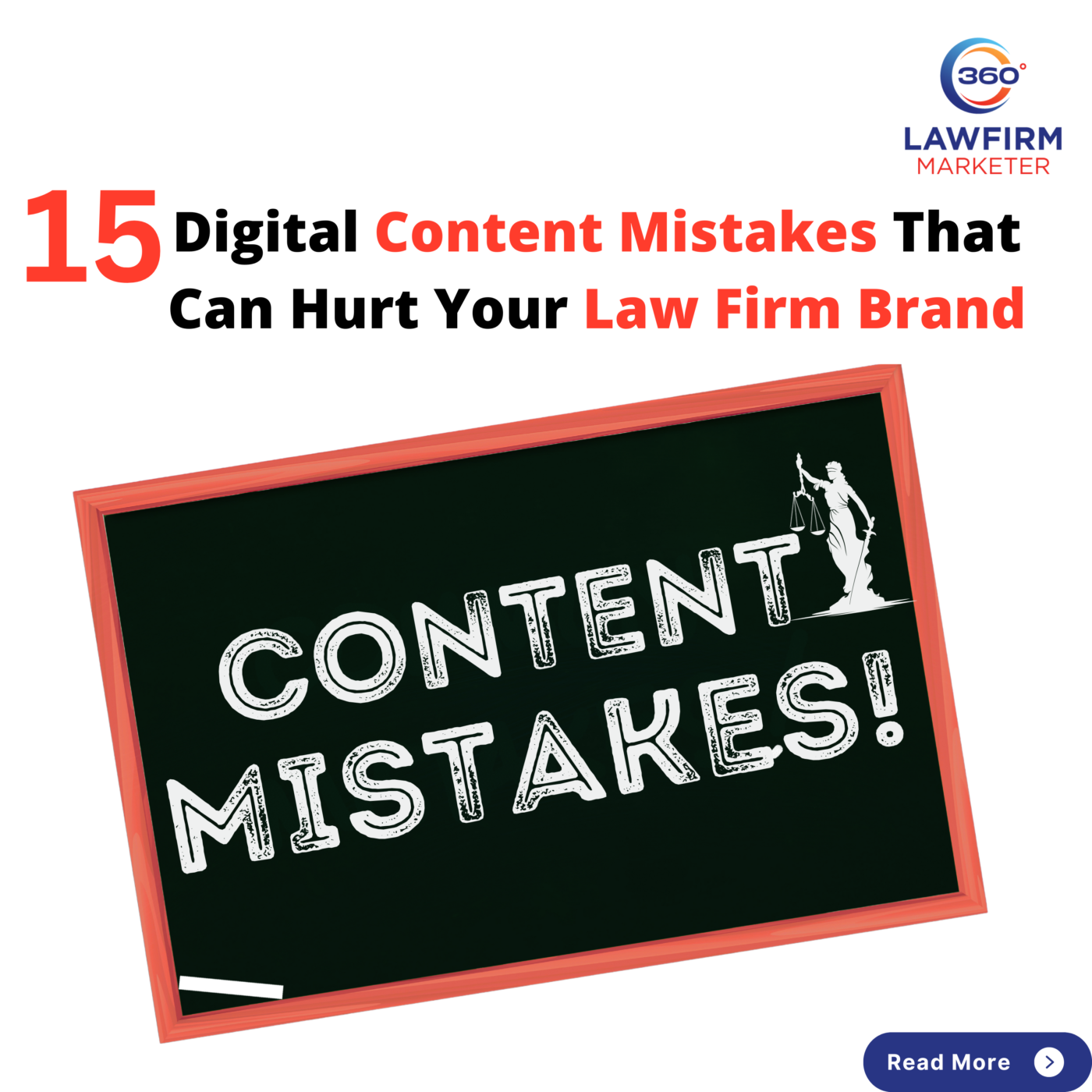15 Digital Content Mistakes That Can Hurt Your LawFirm Brand

Chances are you’ve heard the phrase “content is king”. This is the reality in today’s marketing landscape. However, just as great content can propel your growth, bad content can hurt your brand and make a negative impact. Here are some of the most common mistakes that can make a negative impression when marketing law firms.
Content Marketing Mistakes to Avoid When Marketing Law Firms
1. Going Overboard with Promotional Content
Reading this type of content is similar to being stuck in a conversation with a bragger. Just hearing how great your firm is won’t be interesting to readers. According to the Content Marketing Institute, you should follow the 80/20 rule, with no more than 20% of your content involving self-promotion. When choosing what to publish, put your audience first.
2. Inundating with Email
If your law firm’s departments tend to be siloed, you are at risk of over-emailing your database. For example, if contacts receive a marketing email, then an automated newsletter, then a request for feedback from your client service team, they will start to tune out your emails. Make sure to coordinate with other departments and review your workflows to ensure that recipients aren’t getting too many emails in a short timeframe.
3. Leaning into Negative Content
It’s become a trend that negative content is more likely to be clicked on and shared, but that doesn’t mean you should produce more of it. If you are going to talk about difficult topics, try to focus on the solution or other upsides.
4. Bringing up Controversial Subjects
It’s a good idea to avoid politics and religion in any form of content. Bringing up highly polarizing topics is not a good play when marketing law firms unless they are part of your core business or mission.
5. Publishing Poor Writing or Design
No matter how compelling your content is, if it is full of grammar mistakes, unappealing graphics, or language that’s hard to read, it will only receive negative attention. Always take the time to proofread and use high-quality graphic design elements. Avoid using too much complex legal jargon that may leave readers confused.
6. Using an Inconsistent Voice
Your content should mirror your firm’s general tone and personality. It’s ok to vary your messages, but make sure the material reflects your core personality.
7. Using Boring Subject Lines
According to one study, 64% of respondents say that they decide to open emails based on subject lines. Create subject lines that encourage people to open the email and let them know what they will get out of it.
8. Using the Same Content on Every Platform
It’s important to remember that social media channels are not all the same. Each has a unique audience with different interests and demographics. While cross-posting some content is a time-saver, you don’t want to do it too much or you’ll alienate some social media users. When marketing law firms on social media, think about each platform and the audience that uses it and tailor content accordingly.
For more information on platform-specific tools and best practices, check out this complimentary eBook: Advanced Social Media Strategies for Law Firms.
9. Not Giving Credit
Using someone else’s content and passing it off as your own is a bad look. Most content creators wouldn’t do this on purpose, but using images, quotes, survey results, or other elements without linking or citing the original sources is problematic. When you use information from another source, cite it and link to the original publisher.
10. Over-using Hashtags
Hashtags have an important purpose: they help people to find your content and help to make your content visible. However, adding too many can make the content difficult to read and dilute the impact of your message. In most cases, using between 3-5 hashtags per post is good enough.
11. Posting User-generated Content Without Reviewing
User-generated content can play an important role when marketing law firms. However, posting indiscriminately can be bad for your brand. If you are going to post user-generated content, always do your research. Review the creator’s profile, double-check any facts published, etc.
12. Writing About Topics That Aren’t Relevant to Your Audience
As we mentioned above, keeping your audience in mind is paramount to content that performs well. As you create content, ask yourself if it’s appropriate for your readers. Will they find value in your information? How informed are they already on the subject matter? What else do they need to know?
13. Including Outdated or Incorrect Information
You want to be viewed as an authority and credible source of information in your niche. That’s unlikely to happen if you are sharing information that’s not true. If new information comes out that makes your previous content inaccurate, take it down. Always fact-check and include the latest facts. Whether your content is old or new, make sure not to publish something unless you have proof.
14. Trying to Game the SEO System
In the old days, content stuffing and creating extra pages of content for the purposes of SEO could work. Now, Google and other search engines are more focused on expertise, authoritativeness, and trustworthiness (EAT). They are looking for content that meets the searcher’s intent. Serving that purpose is the most important thing to keep in mind when posting online content.
15. Following Trends that Aren’t On-brand
Hopping on viral trends can be an impactful way to drive new traffic. However, what you’re posting needs to align with other content that you’ve posted and your overall tone. Don’t confuse your audience by posting content that has nothing to do with your brand, just because it’s popular at the moment.
Takeaway:
Making any of these content marketing mistakes can hurt your brand. At the very least, these errors can prevent your content from being effective and helping you to reach your goal. Make sure to steer clear of these actions when creating content. Our goal with digital content marketing is to strike a balance between communicating clearly what you want to get across and creating content that’s important to your audience. If your law firm struggles with content marketing, start with this guide to help.





